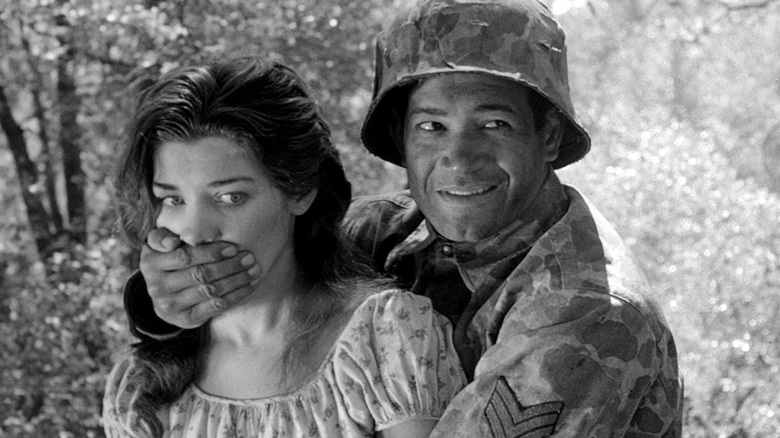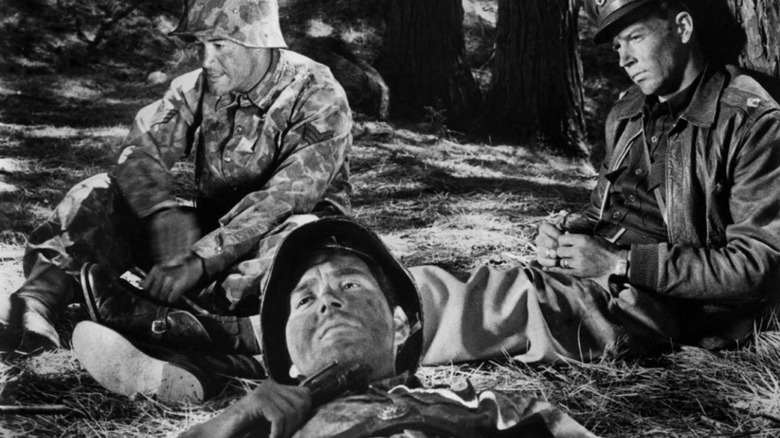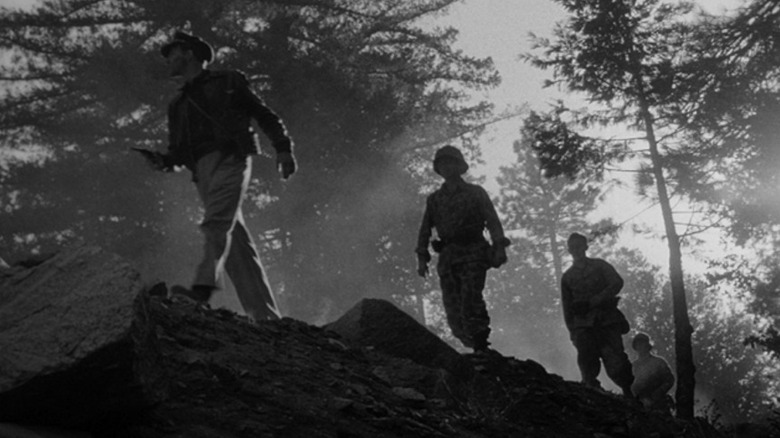Stanley Kubrick's First Project Was A Daring War Movie
Stanley Kubrick has often been accused of being a cold, mannered filmmaker. His celebrated cinematic mastery and notorious perfectionism have resulted in beautifully composed but emotionally distant movies, with protagonists who aren't so much people as puppets in Kubrick's psychological dramas.
These are fair criticisms, but one should immediately note that they are usually only applied to Kubrick's later movies. Kubrick's signature "coldness" — marked by long shots, long takes, and slower editing — didn't really begin until he made "2001: A Space Odyssey" in 1968, and that film wasn't so much about a single character as it was about the whole of humanity. Others familiar with his work on "The Shining" have noted how strangely inhuman all the characters feel. Prior to 1968, however, Kubrick was a wholly personable (if not a cynical) filmmaker, and his early films — including "Fear and Desire," "Killer's Kiss," "The Killing," "Paths of Glory," "Spartacus," "Lolita," and "Dr. Strangelove" — bore either a naturalistic grit or, in the case of "Spartacus," a traditional Hollywood sheen.
Recall that Kubrick was a news photographer prior to being a filmmaker, and he most commonly took photos of everyday life. Some might have seen his famous boxing photographs from 1949. He wasn't setting up shots and arranging fictions. He was capturing the real world.
That real-world grit is all over Kubrick's first feature, an antiwar film called "Fear and Desire" that was released in the United Stated in the spring of 1953. Kubrick had already cut his teeth with two documentary shorts, and decided the time was right to make a scripted feature. It was a tiny affair. The budget was reportedly less than $50,000, with a lot of it coming from Kubrick's friends and family.
Kubrick, we shall later learn, hated the outcome. He infamously tried to destroy the original negative.
Fear and Desire is a bleak antiwar film
"Fear and Desire" was a modest affair. It had a full crew of only 14 people, including Kubrick and the five members of the cast. The film was shot out in the San Gabriel Mountains of California, where hundreds of low-budget movies, and Hollywood movies, would congregate. It was also, when compared to the staid expertise of Kubrick's later movies, a little bit shabby. Kubrick initially intended to shoot the film without sound to save money, but then decided that sound was necessary, adding to the budget. He also accidentally made a continuity error late in the film — a character enters the frame from the wrong side — forcing him to flip the negative, an additional expense.
Kubrick didn't have a dolly or a track to make smooth tracking shots, so he put his camera in a baby carriage. The fog machine was just a crop-sprayer with some of the DDT still lingering inside. Resourceful, low-budget filmmaking at its finest.
The story of "Fear and Desire" follows four soldiers who crash their plane several miles behind enemy lines. The warring nations are never named. The film follows their bleak journey through the woods in an attempt to reach their battalion. They find some enemy soldiers in a house and murder them for their food. They find a peasant girl who meets a dark fate at their hands. One of the soldiers, played by future film director Paul Mazursky ("Moscow on the Hudson"), goes mad. The film ends with an infiltration of an enemy base and a reunion with fellow countrymen, followed by a bleak conversation about the nature of war. "We've all traveled too far from our own private boundaries," one of them says. "I'm all mixed up," the other says. "I wish I could want what I wanted before."
Kubrick tried to burn every print of Fear and Desire
Fun trivia: the peasant girl that is accosted by the Mazursky character was played by actress Virginia Leith, who played the vengeful severed head in the popular B-movie "The Brain that Wouldn't Die."
"Fear and Desire" debuted at the Venice Film Festival in the summer 1952, and was released in theaters the following spring. It wasn't a hit. It came and went without notice. Sadly, the film's distributor, a man named Joseph Burstyn, passed away in November of 1953, leaving the fate of "Fear and Desire" unknown. Burstyn's company went out of business, and the only known print remained with Kubrick. As film students can readily tell you, Kubrick tried to burn it. Indeed, Kubrick was so grossed out by his final movie, he sought to scoop up all the prints he could find and destroy them as well. He felt that the film was amateurish.
Luckily for audiences, some collectors kept several prints of "Fear and Desire," and it lived long enough to be revived at the Film Forum in Greenwich Village. Specifically, the print in question belonged to the George Eastman House, a photography museum. Kubrick tried to shut down the Film Forum exhibition, but couldn't since the film's copyright had lapsed and it was now in the public domain. It wouldn't be until 2010 that a full, complete, original print of "Fear and Desire" would emerge, after being found in a film lab in Puerto Rico. It has since been wholly restored and can now be found on Blu-ray. Also, since it's in the public domain, you can simply watch the whole film on YouTube.
Kubrick downplayed how good "Fear and Desire" is. The dialogue is a little mawkish and preachy, and the violence a little hard-edged, but the misty, contemplative tone makes the film unique. Kubrick may have been known for his mastery of the cinematic craft, so it's refreshing for aspiring filmmakers to see that he, too, started in the low-budget trenches.


